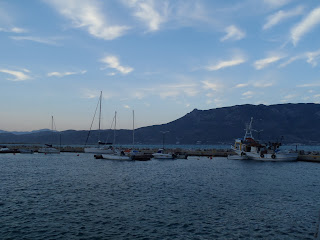.... home to the world-renowned Museum of the Greek Olive and Olive Oil!
In reality it's pretty much what it looks like here-- a mid-sized city suffering from the nationwide economic downturn. Needless to say, it was quite a letdown after expecting to be met by a fully operational civilian militia or something like it. That said, the area just outside the city is just as scenic as the rest of Greece we've encountered so far:
Sparta with Mt. Taygetos in the background
Crossing over from Laconia into Messenia
Because we're constantly moving and we have a relatively big group, we travel in a big coach bus. This basically makes us a 60-year-younger version of the leaf-peepers that always come to Dartmouth. Now, I've long said, "The day you see me getting on a bus to ride around New England and look at leaves, please take me out back and shoot me." And I think I still stand by this statement, but I sort of see where they're coming from. Because there are only 16 people in our group and we have a huge bus, I get the whole back row to myself.
And as it turns out, it's a pretty sweet way to see the countryside. If you carefully read the last sentence, you'll see that I didn't say that it would be a pretty sweet way for all of you to see the Greek countryside, because it won't. If you have looked read the last posts, you know that I suck at photography and that my camera holds between 5 and 7 pictures at once due to my lack of a memory card:
... and some of the better ones from moving and non-moving vantage points:
Kalamata
Mani Peninsula
One aspect of Greek society that has been particularly troubling to me is that despite their long history of intellectual and philosophical innovation, they apparently cannot, even if they combine all of their collective brainpower and resources, design a fucking shower that works properly. At every hotel, we find a brilliant new example of inept shower design. We have seen everything from showers with no curtain or door to ones where the shower head falls off the wall when you turn the water off. Here is the worst version yet:
Water sprays from the shower head in all directions, so you soak the whole bathroom and any dry clothes, towels, etc that might be in it. Apparently you're supposed to ball up in the corner and kind of hold the handle over your head or something.
Another interesting cultural difference I've noticed is something I like to call the "two dudes, one moped" phenomenon. It's just what it sounds like- two grown men riding around on a moped together- and it's hilarious. The most entertaining aspect is the variety of ways to make it look casual. My personal favorites are the "lean-back-and-cross-the-arms" method and the "I'm-just-checking-my-phone" method. Unfortunately, I don't have a great picture yet, but but this gives you an idea:
The Cam and Lauriel Take on The Greece Fan of the Week is Scott. I hear he's been spreading the word down at Thayer, which is great to hear. I would like to give a shoutout to Scott and the rest of the Thayer community down in Couch Lab... So many memories!
Cam Woodworth, Th '13













.JPG)













